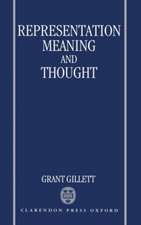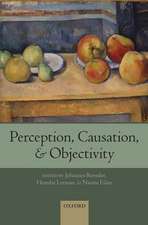Vitalism and the Scientific Image in Post-Enlightenment Life Science, 1800-2010: History, Philosophy and Theory of the Life Sciences, cartea 2
Editat de Sebastian Normandin, Charles T. Wolfeen Limba Engleză Hardback – 28 iun 2013
| Toate formatele și edițiile | Preț | Express |
|---|---|---|
| Paperback (1) | 892.31 lei 38-44 zile | |
| SPRINGER NETHERLANDS – 15 iul 2015 | 892.31 lei 38-44 zile | |
| Hardback (1) | 1120.05 lei 6-8 săpt. | |
| SPRINGER NETHERLANDS – 28 iun 2013 | 1120.05 lei 6-8 săpt. |
Din seria History, Philosophy and Theory of the Life Sciences
- 15%
 Preț: 642.83 lei
Preț: 642.83 lei - 18%
 Preț: 735.84 lei
Preț: 735.84 lei - 15%
 Preț: 644.95 lei
Preț: 644.95 lei - 9%
 Preț: 627.82 lei
Preț: 627.82 lei -
 Preț: 349.63 lei
Preț: 349.63 lei - 18%
 Preț: 1240.76 lei
Preț: 1240.76 lei - 18%
 Preț: 785.55 lei
Preț: 785.55 lei -
 Preț: 398.63 lei
Preț: 398.63 lei - 15%
 Preț: 701.06 lei
Preț: 701.06 lei -
 Preț: 389.11 lei
Preț: 389.11 lei - 15%
 Preț: 651.02 lei
Preț: 651.02 lei -
 Preț: 391.22 lei
Preț: 391.22 lei - 15%
 Preț: 646.43 lei
Preț: 646.43 lei - 24%
 Preț: 590.18 lei
Preț: 590.18 lei - 15%
 Preț: 644.49 lei
Preț: 644.49 lei - 15%
 Preț: 583.78 lei
Preț: 583.78 lei - 5%
 Preț: 1103.39 lei
Preț: 1103.39 lei -
 Preț: 438.69 lei
Preț: 438.69 lei - 15%
 Preț: 693.57 lei
Preț: 693.57 lei - 15%
 Preț: 638.57 lei
Preț: 638.57 lei - 5%
 Preț: 906.63 lei
Preț: 906.63 lei - 15%
 Preț: 692.09 lei
Preț: 692.09 lei -
 Preț: 353.99 lei
Preț: 353.99 lei - 18%
 Preț: 949.23 lei
Preț: 949.23 lei - 18%
 Preț: 735.21 lei
Preț: 735.21 lei - 18%
 Preț: 725.75 lei
Preț: 725.75 lei - 18%
 Preț: 792.19 lei
Preț: 792.19 lei -
 Preț: 357.63 lei
Preț: 357.63 lei - 24%
 Preț: 713.96 lei
Preț: 713.96 lei -
 Preț: 354.38 lei
Preț: 354.38 lei
Preț: 1120.05 lei
Preț vechi: 1365.91 lei
-18% Nou
Puncte Express: 1680
Preț estimativ în valută:
214.35€ • 232.75$ • 180.05£
214.35€ • 232.75$ • 180.05£
Carte tipărită la comandă
Livrare economică 23 aprilie-07 mai
Preluare comenzi: 021 569.72.76
Specificații
ISBN-13: 9789400724440
ISBN-10: 9400724446
Pagini: 496
Ilustrații: VI, 377 p. 5 illus.
Dimensiuni: 155 x 235 x 27 mm
Greutate: 0.77 kg
Ediția:2013
Editura: SPRINGER NETHERLANDS
Colecția Springer
Seria History, Philosophy and Theory of the Life Sciences
Locul publicării:Dordrecht, Netherlands
ISBN-10: 9400724446
Pagini: 496
Ilustrații: VI, 377 p. 5 illus.
Dimensiuni: 155 x 235 x 27 mm
Greutate: 0.77 kg
Ediția:2013
Editura: SPRINGER NETHERLANDS
Colecția Springer
Seria History, Philosophy and Theory of the Life Sciences
Locul publicării:Dordrecht, Netherlands
Public țintă
ResearchCuprins
Introduction.- Part I. Revisiting vitalist themes in 19th-century science.- 1. Guido Giglioni (Warburg Institute); Jean-Baptiste Lamarck and the Place of Irritability in the History of Life and Death.- 2. Joan Steigerwald (York); Rethinking Organic Vitality in Germany at the Turn of the Nineteenth Century.- 3. Juan Rigoli (Geneva); The ‘Novel of Medicine’.- 4. Sean Dyde (Cambridge); Life and Mind in Nineteenth-Century Britain: Somaticist 'Mind' and Body after the Death of Phrenology.- Part II. Twentieth century debates on vitalism in science and philosophy.- 5. Brian Garrett (McMaster); Vitalism versus Emergent Materialism.- 6. Christophe Malaterre (Paris); Life as an Emergent Phenomenon: From an Alternative to Vitalism to an Alternative to Reductionism.- 7. Sebastian Normandin (Montreal); Wilhelm Reich: Vitalism and Its Discontents.- 8. Chiara Elettra Ferrario (Wellington) and Luigi Corsi (Pisa); Kurt Goldstein: Vitalism
and the Organismic Approach.- 9. Giuseppe Bianco (Paris/Warwick); The Origins of Canguilhem’s “Vitalism”: Against the Anthropology of Irritation.- Part III. Vitalism and contemporary biological developments.- 10. J. Scott Turner (Syracuse); Homeostasis and the forgotten vitalist roots of adaptation.- 11. Carlos Sonnenschein, David Lee, Jonathan Nguyen and Ana Soto (Tufts); Unanticipated trends stemming from the history of cell culture: Vitalism in 2012?.- 12. John Dupré and Maureen O’Malley (Exeter); Varieties of living things: Life at the intersection of lineage and metabolism.- 13. William Bechtel (UCSD); Dynamic Mechanistic Explanation: Addressing the Vitalists’ Objections to Mechanistic Science.
and the Organismic Approach.- 9. Giuseppe Bianco (Paris/Warwick); The Origins of Canguilhem’s “Vitalism”: Against the Anthropology of Irritation.- Part III. Vitalism and contemporary biological developments.- 10. J. Scott Turner (Syracuse); Homeostasis and the forgotten vitalist roots of adaptation.- 11. Carlos Sonnenschein, David Lee, Jonathan Nguyen and Ana Soto (Tufts); Unanticipated trends stemming from the history of cell culture: Vitalism in 2012?.- 12. John Dupré and Maureen O’Malley (Exeter); Varieties of living things: Life at the intersection of lineage and metabolism.- 13. William Bechtel (UCSD); Dynamic Mechanistic Explanation: Addressing the Vitalists’ Objections to Mechanistic Science.
Recenzii
“It has provided language and frameworks for defining the nature of life that can be employed in concert with other philosophical doctrines. Indeed, by the end of the book, the essayists argue that vitalism is materialistic, and materialism is vitalistic. … The volume is worthwhile for any active philosophy of science program. Summing Up: Recommended. Upper-division undergraduate, graduate students, and researchers/faculty.” (A. K. Ackerberg-Hastings, Choice, Vol. 51 (6), February, 2014)
“The editors have assembled a fascinating selection of papers that examine the history of vitalism and trace its various developments from the end of the Enlightenment to the modern day, reassessing both its historical and conceptual import. … a compelling and insightful volume, which puts the spark back into the contemporary Vitalist debate.” (Adam Ferner, Philosophy, February, 2014)
“This collection is a rare and much welcome collective review of the diversity, vigor, and transform
ations of post-Enlightenment vitalism and associated schools of thought. It provides historical insights that are otherwise not available. … this book greatly enriches and complicates our understanding of modern vitalism.” (Ku-ming (Kevin) Chang, Early Science and Medicine, Vol. 19 (4), 2014) “Vitalism and the Scientific Image in Post-Enlightenment Life Science brings together cutting-edge analyses that will be of lasting interest to historians and philosophers of the life sciences and medicine, as well as to scientists working in these and related areas. … All three sections contain engaging essays that make important contributions to either the history of vitalism, its conceptual foundations, or its metaphysical assumptions.” (Pierre-Olivier Méthot, Journal of the History of Biology, Vol. 47, 2014)
“The present volume is distinctive in
its broad construal of vitalist arguments on the one hand, and on the other, its stated attempt to relate vitalism to the prevalent views of what it meant and means to be scientific. … The editors of this rich and diversified volume have gone a long way towards enabling the readers to concurrently study the intricate past of the problematique of vitalism and through its understanding, deeply enrich contemporary work and thinking.” (Snait B. Gissis, Studies in History and Philosophy of Biological and Biomedical Sciences, Vol. 47, 2014)
“The editors have assembled a fascinating selection of papers that examine the history of vitalism and trace its various developments from the end of the Enlightenment to the modern day, reassessing both its historical and conceptual import. … a compelling and insightful volume, which puts the spark back into the contemporary Vitalist debate.” (Adam Ferner, Philosophy, February, 2014)
“This collection is a rare and much welcome collective review of the diversity, vigor, and transform
ations of post-Enlightenment vitalism and associated schools of thought. It provides historical insights that are otherwise not available. … this book greatly enriches and complicates our understanding of modern vitalism.” (Ku-ming (Kevin) Chang, Early Science and Medicine, Vol. 19 (4), 2014) “Vitalism and the Scientific Image in Post-Enlightenment Life Science brings together cutting-edge analyses that will be of lasting interest to historians and philosophers of the life sciences and medicine, as well as to scientists working in these and related areas. … All three sections contain engaging essays that make important contributions to either the history of vitalism, its conceptual foundations, or its metaphysical assumptions.” (Pierre-Olivier Méthot, Journal of the History of Biology, Vol. 47, 2014)
“The present volume is distinctive in
its broad construal of vitalist arguments on the one hand, and on the other, its stated attempt to relate vitalism to the prevalent views of what it meant and means to be scientific. … The editors of this rich and diversified volume have gone a long way towards enabling the readers to concurrently study the intricate past of the problematique of vitalism and through its understanding, deeply enrich contemporary work and thinking.” (Snait B. Gissis, Studies in History and Philosophy of Biological and Biomedical Sciences, Vol. 47, 2014)
Textul de pe ultima copertă
Vitalism is understood as impacting the history of the life sciences, medicine and philosophy, representing an epistemological challenge to the dominance of mechanism over the last 200 years, and partly revived with organicism in early theoretical biology. The contributions in this volume portray the history of vitalism from the end of the Enlightenment to the modern day, suggesting some reassessment of what it means both historically and conceptually. As such it includes a wide range of material, employing both historical and philosophical methodologies, and it is divided fairly evenly between 19th and 20th century historical treatments and more contemporary analysis. This volume presents a significant contribution to the current literature in the history and philosophy of science and the history of medicine.
Caracteristici
First comprehensive overview of Vitalism: an idea with ever increasing relevance to modern biological theory Comprehensive overview of multi- and trans- disciplinary approaches Combination of historical and contemporary analysis















![British Empirical Philosophers (Routledge Revivals): Locke, Berkeley, Hume, Reid and J. S. Mill. [An anthology]](https://i4.books-express.ro/bt/9780415537742/british-empirical-philosophers-routledge-revivals.jpg)


